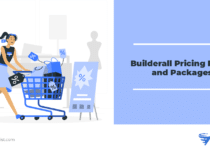Why choose and use Leadpages: The Benefits
Leadpages is designed for creating landing pages, pop-ups, alert bars, and even complete websites. It appeals to both WordPress and non-WordPress users who want to grow their business or increase their audience.
With an impressive library of high-quality templates, a modern content editor, and some handy optimization tools, Leadpages has everything you need to start collecting email addresses from your visitors, generating registrations, and selling products and services online. It helps its users generate more leads and sell more online.
If you want to know more about what this tool offers and whether it can help you achieve your goals, read on.
Get our FREE course on funnel building and marketing. We'll deliver it straight to your inbox! Learn about how to build and market your funnels for your business. The course includes a full tutorial on how to use ClickFunnels.![]()
Leadpages Overview
Leadpages allows you to create landing pages that they can host and publish for you on a custom domain. Alternatively, you can add those landing pages and other conversion-focused content like pop-ups and alert bars to your WordPress website.
Leadpages is one of the most popular landing page builders for small and medium-sized businesses. Leadpages promises to help business owners build landing pages, add pop-ups and alert bars quickly.
You can also create an entire website with Leadpages, giving you a quick way to launch an online presence for your latest project.
Since your Leadpages account includes hosting for any landing pages and sites you create, you don’t need anything else to get started but if you have your own domain, you can use that too. (READ: Frequently Asked Questions on Leadpages)
Whether you want to grow your email list, generate registrations for an event, or encourage your audience to perform some other action, Leadpages can help. It offers the following:
-
A huge library of customizable templates
Leadpages has an impressive library of editable templates for creating landing pages and other types of content. It has more than 150 templates to choose from to help you start creating effective landing pages as quickly as possible.
The templates do not only look highly professional, but they’ve also been optimized for the best results. In fact, the Leadpages team optimize their templates based on the data they can collect by hosting thousands of pages for their users. You can even sort the templates by conversion rate to find the best designs quickly.
Among the landing page templates are options for generating webinar or virtual event sign-ups, promoting offers, selling products, and many more. If you’re a service provider, such as a freelancer or a consultant, some templates can help you generate more business, too.
-
Quick Start Wizard
It’s awesome to have access to many high-quality templates. However, an extensive library can end up getting you confused, not to mention the amount of time it takes to view all of your options and then make a final decision.
Since there are many templates to choose from, the Quick Start Wizard will narrow down your options and speed up the decision-making process. Once you have reached a decision, you will be taken to the content editor where you can start customizing your chosen template.
To help you get started with Leadpages, you’re asked a few questions after signing up. This will help you to find the right template with as little time and effort as possible. Your answers will narrow down your options until you get to the set of templates best suited to your goals. Once you’ve walked through the few steps of the start guide, you’ll be provided with relevant templates to choose from.
-
Conversion tools
Besides creating pages, you can also create pop-ups and alert boxes and then add them to your website, including WordPress websites, to generate more leads.
-
Landing Page Builder
The landing page builder is a modern page editor and is one of Leadpages’ top features. Anyone can start customizing the landing pages and other templates due to its highly user-friendly interface.
You only need to click on a page element to reveal the customization controls. This will allow you to change its color, adjust its borders, or set what happens when someone clicks on it. If you want to change any text, simply click on it and start typing.
Adding widgets to your pages is also pretty easy. Simply drag and drop one of the available options into your page, and then you can edit it.
Whether you want to start from a blank canvas and create your own unique landing page or customize one of the templates, the drag-and-drop builder makes the process simple.
Leadpages don’t have as many widgets as other page builder plugins, but there should be enough options for most projects. Since this is a landing page builder rather than a general-purpose page builder, it makes sense that the range of widget options are narrower.
While you work on your project, you don’t have to worry about diluting the highly optimized templates’ effectiveness with your edits.
-
Split testing
This feature is very useful if you want to create data-driven for your landing pages and other conversion-focused content. All of the Leadpages have been built for high conversions but you can also run your own tests to see which of your designs get the best response from your audience to remove all of the guesswork from creating landing pages.
Leadpages also has a Leadmeter to help you to optimize your pages as you build them. It is based on the data Leadpages has gathered from hosting thousands of landing pages for its customers.
Once your project goes live, you can begin testing your designs using your audience’s visitor data. You’ll not only use the Leadpages reporting tools to see how well your designs are performing but you can also use the split testing tool to create multiple variations of your landing pages and then show these versions to portions of your visitors.
All you need to do is create the different versions of your page and Leadpages will take care of showing them to different segments of your audience. Once the test begins collecting data, you see quickly whether your audience responds better to a particular version of your page.
-
Integration options
Leadpages integrates with several third-party services, including payment processors, email marketing tools, and social media advertising platforms, to name just a few.
All the landing pages, sites, and conversion tools you create using Leadpages can be integrated with over 40 different tools and services. The options are divided into the following categories:
- Analytics including Google Analytics
- CRM including Salesforce
- Digital Advertising including Facebook and Google Ads
- eCommerce including Shopify
- Email marketing including AWeber
- Live chat including Drift
- Marketing automation including HubSpot
- Payments including PayPal
- Scheduling including Calendly
- Social media, including Facebook
- Video including GoToWebinar
- Website including WordPress
- A miscellaneous category of other integrations
(READ: How to integrate GetResponse with Leadpages)
Whatever type of service or tool you want to integrate with your landing pages, you’ll probably find a supported option.
Other Features of Leadpages
While the core features of Leadpages are its builder, websites, and conversion tools for your websites, there are a few other features that are worth mentioning:
- The Checkout feature allows you to collect payments for products and services through Stripe.
- There are automatic SSL encryptions for your pages and sites.
- There is a one-on-one quick start call for new customers.
- Telephone, email, and live chat support channels are available depending on your chosen plan.
- There is a file delivery system for sending lead magnets to subscribers.
Leadpages Pricing
Leadpages offers a free trial for 14 days before making your first payment.
However, upon signing up, you’ll need to choose from the following pricing plans:
Standard Plan
This plan supports one site and costs $27 a month if billed annually or $37 a month if billed monthly.
Pro Plan
This plan supports three sites and costs $59 a month when billed annually or $79 a month when billed monthly.
Advanced Plan
This plan supports up to 50 sites and costs $239 a month when billed annually or $321 a month when billed monthly.
Pros and Cons of Leadpages
Below is a quick overview of the main pros and cons of this platform:
Pros
- Many high-quality editable templates for a range of projects
- Easy-to-use landing page editor
- Can be used with or without an existing website
- A built-in split testing tool and conversion reporting
- Fees are not based on how many visitors or lead your pages generate, unlike tools like Instapage
- Its free 14-day free trial gives you time to try the features and see if they produce results
Cons
- Leadpages’ builder doesn’t give you as much creative freedom compared with other tools.
- The Leadmeter doesn’t work on all templates.
- It’s more expensive than most of the top WordPress page builder plugins.
Whether you want to create an online presence, generate more leads, or scale up your business, Leadpages has all of the features you need.
This tool is very easy to use, with some helpful features that make it perfect for those with minimal experience in creating websites or designing content.



